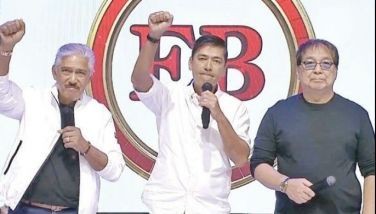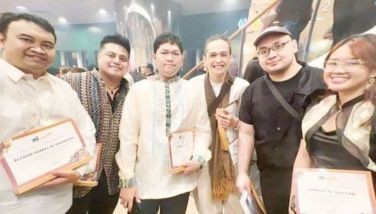Bayan Ko and other patriotic songs
As we pause to commemorate the valor of the heroes of the Death March in Bataan come the Araw ng Kagitingan on April 9, let us also take a look and I hope also a listen to some songs that extol the virtue of being a true Filipino.
Bayan Ko, 1927, music by Constancio de Guzman, lyrics by poet, dramatist and actor Jose Corazon de Jesus, first performed by future National Artist, zarzuela actress and singer Atang de la Rama. This kundiman is about the Philippines’ struggle for independence during the American regime. Because of this nationalistic sentiment, the song was also performed to convey the same desire for freedom during the Japanese occupation and during protest marches against the Marcos government in the early ‘80s. It is without doubt the most beautiful and stirring of patriotic songs. I do not know if a recording by De La Rama exists but if you want a copy, there is an excellent version by Freddy Aguilar.
Ugoy Ng Duyan, 1943. Two future National Artists met on board a ship on their way home from the United States. Composer Lucio San Pedro told lyricist Levi Celerio that he had a melody in need of words. Celerio rose to the occasion and came up with Ugoy Ng Duyan. What they intended as a lullaby for San Pedro’s mother has since then become the lament of every Filipino who is forced to live abroad and longing to be back home in the arms of the motherland.
Ang Himig Natin, 1973, music by the Juan de la Cruz Band composed of Mike Hanopol, Joey Smith and Wally Gonzales with lyrics by Smith. This plaintive plea for unity struck a vivid chord among the restless youth of the ‘70s era. “Ang himig natin ang inyong awitin/ upang tayo’y magsama-sama sa langit ng pag-asa.” The song, which used Tagalog words with a Western melody also marked the beginning of Pinoy Rock in the Philippines.
Ang Bayan Kong Sinilangan, 1978, composed and performed by Pendong Aban, Nonoy Pillora Jr., Sara Banares and Lolita Carbon, members of the folk-rock group collectively known as Asin. Ang Bayan Kong Sinilangan is one of several hits popularized by Asin. It is as Filipino as the other songs on this list but it differs in that instead of asking for hope or unity or extolling the virtues of Filipinos, it takes a hard look at the war in Mindanao. Sad to say, the war still rages and Ang Bayan Kong Sinilangan could have been written yesterday. “Ang bayan kong Cotabato kasing gulo ng isip ko/ di alam kung saan nanggaling/ di alam kung saan patungo/ kapatid sa kapatid, laman sa laman/ sila-sila ang naglalaban/ di ko alam ang dahilan ng gulo.”
Tayo’y Mga Pinoy, 1978, words and music by Heber Bartolome, first performed as a finalist at the first Metropop Song Festival by Heber and his group, Banyuhay. This is a protest against colonial mentality and an appeal to Filipinos to be proud of who they really are. “Tayo’y mga Pinoy/ tayo’y hindi kano/ huwag lang mahihiya/ kung ang ilong mo ay pango.” Bartolome set his lyrics against a deceptively simple melody that mixes kundiman with Pinoy folk rock.
Magkaisa, composed by Tito Sotto with Ernie de la Pena and Homer Flores and recorded by Virna Lisa. As the People Power Revolution raged around his recording studio in the White Plains area in February, 1986, music producer and later senator, Sotto felt inspired to write a song. With the melody done, he next brought in his friends, lyricist De la Peña and arranger Flores to finish his new composition. He then called in the totally unknown singer Lisa. Released into the airlanes on March 1, the result was the soaring Magkaisa, a message of hope and unity, which to this day evokes the euphoric images of victory against the Marcos regime. “Magkaisa, may pag-asa kang matatanaw/ at magsama, bagong umaga, bagong araw/ kapit kamay, sa bagong pag-asa.”
Ako’y Isang Pinoy, 1977, words and music by Florante de Leon. Folk rock icon Florante created many memorable songs during the late ‘70s period. His ability to put a down-home spin to any topic endeared him to fans and made him a star. Remember Handog, Digmaan, Pinay, A Ba Ka Da? For his memorable song, Ako’y Isang Pinoy, he took on his English-speaking countrymen and reminded them that he is a Filipino with his own language. “Ako’y Isang Pinoy sa puso’t diwa/ Pinoy na isinilang sa ating bansa/ hindi ako sana’y sa wikang banyaga/ ako’y Pinoy/ isang Pinoy/ sa aking wika.”
Mga Kababayan Ko, composed and recorded by Francis Magalona, arranged by Jimmy Antiporda and released by OctoArts International in 1990. Magalona, son of showbiz legends Pancho Magalona and Tita Duran, started his career as one of the newbie actors in the Bagets series of films. But it was as a rapper with Mga Kababayan Ko that he ensured his own success and immortality. The song not only marked the beginning of Pinoy rap, it also encouraged young Filipinos to have pride in their heritage.
Space forbids me to add more so I hope you readers will think of those I missed and reflect on what those songs say about the Filipino.
- Latest
- Trending

























 Exclusive
Exclusive


